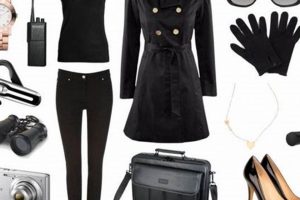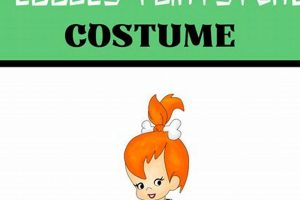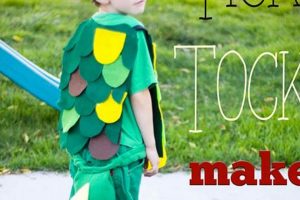The creation of self-fashioned female Norse attire involves constructing garments and accessories reminiscent of those worn by women in Viking Age Scandinavia. This encompasses a range of techniques, from sewing historically inspired dresses and aprons to crafting jewelry and headwear reflecting the aesthetics of the period. An example includes stitching a linen underdress, layering it with a wool apron dress, and complementing the ensemble with hand-crafted beads and a simple headscarf.
Producing one’s own interpretation of historical female Scandinavian clothing offers numerous advantages. It allows for personalization of design, ensuring a unique and individualized final product. Cost-effectiveness can also be realized, particularly when sourcing materials economically or repurposing existing fabrics. Furthermore, the act of constructing such garments can provide a deeper connection to the historical period, fostering an appreciation for the craftsmanship and resourcefulness of the people who lived during the Viking Age.
The following sections will detail specific aspects of constructing such a garment, including material selection, pattern adaptation, and accessory creation, facilitating a historically informed and aesthetically pleasing final result.
Tips for Crafting Authentic-Looking Female Norse Attire
Achieving a convincing visual representation of Viking Age female clothing requires careful attention to detail and historical accuracy. The following tips offer guidance in replicating the style and construction techniques of the period.
Tip 1: Prioritize Natural Fibers: Garments from the Viking Age were primarily constructed from wool, linen, and occasionally silk for higher-status individuals. Avoid synthetic fabrics as they lack the texture and drape of historical materials. Linen works well for underdresses and wool for overdresses and cloaks.
Tip 2: Opt for Simple Construction: Viking Age clothing utilized relatively simple construction techniques. Focus on basic geometric shapes and avoid complex tailoring. Rectangular panels were often used to form the body of dresses, with gores added for fullness.
Tip 3: Emphasize Layering: Layering was a fundamental aspect of Viking Age female dress. A linen underdress, often ankle-length, served as a base layer. Over this, an apron dress, typically held in place by brooches at the shoulders, would be worn. Cloaks or shawls provided additional warmth and visual interest.
Tip 4: Research Historical Colors and Dyes: While vibrant colors were present in Viking Age textiles, earth tones and natural dyes were more common. Consider using shades of blue derived from woad, reds from madder, and yellows from weld. Avoid overly bright or synthetic-looking colors.
Tip 5: Invest in Accurate Accessories: Accessories such as brooches, beads, belts, and head coverings are crucial for completing the look. Investigate the styles of brooches and beads found in archaeological sites. Tortoise brooches, often used to secure apron dresses, are a common example.
Tip 6: Hand-Sew When Possible: While machine sewing can be used, hand-sewing adds a level of authenticity to the finished product. Simple stitches like running stitch and back stitch are suitable for most garment construction.
Tip 7: Consider Regional Variations: Viking Age Scandinavia comprised various regions, each with its own distinct style of dress. Research the specific area that one wishes to emulate to ensure greater accuracy.
Adhering to these guidelines will significantly enhance the realism and historical plausibility of self-made female Scandinavian attire, resulting in a more convincing and immersive portrayal.
The succeeding sections will delve further into specific garment types and accessory designs, providing comprehensive instructions for their creation.
1. Material Selection
The choice of materials constitutes a foundational element in the successful creation of self-fashioned female Norse attire. Material selection directly impacts the garment’s appearance, durability, and overall historical plausibility. The adherence to historically accurate fabrics significantly enhances the authenticity of the final product.
- Fiber Type and Origin
The primary fibers used in Viking Age clothing were wool and linen. Wool, sourced from sheep, provided warmth and durability, ideal for outer garments and cloaks. Linen, derived from flax, offered a lighter, more breathable fabric suitable for underdresses. The selection of these specific fiber types is crucial; substituting with modern synthetics compromises historical accuracy and the visual texture of the attire. Sourcing ethically produced, natural fibers further enhances the garment’s overall value.
- Weave and Texture
The weave of the fabric influences its drape and texture. Plain weaves were common in Viking Age textiles, offering a simple and durable construction. The texture should be relatively coarse, reflecting the hand-spun and hand-woven nature of historical fabrics. Avoid smooth, highly processed textiles that lack the character of traditional weaves. Recreating authentic weave patterns contributes significantly to the garment’s visual accuracy.
- Dyeing and Coloration
The method of dyeing and the colors employed also play a vital role. Natural dyes derived from plants and minerals were used to color Viking Age textiles. Shades of blue from woad, red from madder, and yellow from weld were common. Overly bright or synthetic-looking colors should be avoided in favor of muted, earth-toned hues. The use of natural dyeing techniques further enhances the historical authenticity of the materials.
- Fabric Weight and Drape
The weight and drape of the selected fabric are important considerations. Heavier weight wools are suitable for outer garments such as cloaks and overdresses, providing warmth and structure. Lighter weight linens are appropriate for underdresses, offering breathability and comfort. The fabric should drape in a manner consistent with historical garments, avoiding stiffness or excessive clinginess. Selecting fabrics with appropriate weight and drape characteristics ensures a more historically accurate and visually appealing final product.
The careful consideration of fiber type, weave, dyeing methods, and fabric weight collectively contributes to the overall success of self-fashioned female Norse attire. Choosing historically accurate materials is paramount for achieving a visually convincing and authentic representation of Viking Age clothing.
2. Pattern Adaptation
Pattern adaptation is a critical process in the creation of self-fashioned female Norse attire. Because extant patterns from the Viking Age are largely absent, modern individ
uals must adapt existing patterns or create new ones based on archaeological finds and historical interpretations. This adaptation is not merely a cosmetic alteration but a fundamental element influencing the garment’s authenticity and fit. Incorrect adaptation can lead to a final product that, while resembling Viking Age clothing in broad strokes, lacks the structural integrity and aesthetic nuances of historical garments. For instance, a pattern designed for modern tailoring, when used without modification, may incorporate darts or princess seams, features absent from the simpler constructions of the period. Adapting such a pattern requires removing these modern elements and reconstructing the garment using simpler, geometrically shaped panels.
The process of pattern adaptation for female Norse attire necessitates a comprehensive understanding of historical garment construction techniques. Archaeological evidence, such as fragments of textiles recovered from burial sites, provides insights into the shapes and sizes of garment pieces. Based on this evidence, individuals can modify existing patterns for tunics, aprons, and overdresses. One example involves adapting a modern tunic pattern by removing shaping elements and adding gorestriangular or trapezoidal fabric pieces inserted to provide fullnessconsistent with Viking Age garment construction. Another practical application is adjusting the shoulder width and neckline of a modern dress pattern to match the higher necklines and broader shoulders observed in depictions and reconstructions of female Norse attire. Furthermore, pattern adaptation also entails considering the intended use of the garment. Working garments, for example, may require more robust construction and a looser fit than ceremonial attire, influencing the dimensions and shaping of the pattern pieces.
In summary, pattern adaptation is not an optional step but an essential bridge between modern pattern-making and the creation of historically plausible female Norse attire. The challenges inherent in this process necessitate a combination of historical research, pattern-making skills, and a keen eye for detail. The success of a self-fashioned Norse garment hinges significantly on the accuracy and thoughtfulness applied during pattern adaptation, linking the process directly to the broader goal of creating authentic and visually convincing clothing.
3. Construction Technique
The selection and application of appropriate construction techniques are paramount in the successful creation of self-fashioned female Norse attire. These techniques, reflective of the tools and skills available during the Viking Age, directly impact the authenticity, durability, and visual accuracy of the resulting garment. Deviations from historically plausible methods can detract from the overall realism of the endeavor.
- Seam Construction
Historically accurate seam construction primarily involved hand-sewing techniques such as running stitch, back stitch, and whip stitch. These stitches, while time-consuming, closely replicate the appearance and strength of seams found in archaeological textile fragments. Machine stitching, while offering speed and convenience, produces a distinctly different aesthetic and may compromise the historical accuracy of the finished garment. Hand-sewn seams also tend to be more flexible, accommodating the movements of the wearer and reducing stress on the fabric. The choice of stitch type and thread material contributes significantly to the overall durability and aesthetic appeal of the construction.
- Gusset and Gore Insertion
Gussets and gores, geometrically shaped fabric pieces, were commonly used to add fullness and freedom of movement to Viking Age garments. Their strategic placement, often under the arms or at the sides of skirts, allowed for greater range of motion without the need for complex tailoring. Accurate insertion of gussets and gores requires careful pattern planning and precise stitching. Poorly inserted gussets can result in uneven seams or restricted movement, detracting from the functionality and appearance of the garment. The size and shape of these inserts must be carefully considered based on the desired silhouette and the wearer’s measurements.
- Edge Finishing
The treatment of raw edges is an important aspect of garment construction, influencing both the durability and appearance of the finished product. Hemming techniques in the Viking Age typically involved simple folded hems secured with running stitch or whip stitch. More elaborate edge finishes, such as decorative stitching or tablet-woven bands, were sometimes used on higher-status garments. Raw edges left unfinished can lead to fraying and eventual disintegration of the fabric. The choice of edge finishing technique should be appropriate to the fabric type and the intended use of the garment.
- Fastening Methods
Fastening methods in Viking Age clothing were relatively simple, often relying on brooches, pins, belts, or ties. Brooches, particularly tortoise brooches, were commonly used to secure apron dresses at the shoulders. Belts served not only to cinch the waist but also to suspend tools and other necessities. Ties, made from fabric or leather, were used to close openings or adjust the fit of garments. The accurate replication of these fastening methods is essential for achieving a historically plausible look. The use of modern zippers or buttons is generally discouraged, as these were not available during the Viking Age.
The consistent application of historically informed construction techniques is vital for creating convincing and durable self-fashioned female Norse attire. These techniques, when executed with care and attention to detail, enhance the garment’s authenticity and ensure its longevity, allowing the wearer to experience a tangible connection to the past.
4. Historical Accuracy
Historical accuracy constitutes a critical determinant of success in the creation of self-fashioned female Norse attire. The degree to which the costume aligns with verifiable historical evidence directly impacts its visual plausibility and its ability to convey an authentic representation of Viking Age culture. Deviation from established historical facts, in terms of garment construction, material selection, or accessory design, diminishes the costume’s ability to serve as a credible portrayal. The application of accurate historical research serves as the foundational underpinning for all other creative and constructive processes. Failure to prioritize historical accuracy can result in a garment that, while aesthetically pleasing, fails to resonate with the intended historical context. For example, the incorporation of anachronistic elements, such as synthetic fabrics or modern closures, immediately compromises the costume’s historical integrity. The selection of colors and patterns also warrants careful scrutiny, as certain dyes and designs were not available or prevalent during the Viking Age.
The practical significance of prioritizing historical accuracy extends beyond mere aesthetics. A commitment to historical correctness fosters a deeper understanding and appreciation for the skills, resources, and cultural values of the Viking Age. Furthermore, it allows the costume to function as a valuable educational tool, facilitating the transmission of historical knowledge to others. An example is the meticulous r
econstruction of a specific type of brooch based on archaeological finds. By replicating the design and manufacturing techniques of the original artifact, the craftsperson not only creates an accurate accessory but also gains insight into the metalworking skills of Viking Age artisans. Similarly, the use of natural dyes derived from plants or minerals replicates the methods used by Viking Age textile workers, providing a tangible connection to their daily lives.
The pursuit of historical accuracy in self-fashioned female Norse attire presents several challenges. Primary source materials are often fragmented or incomplete, necessitating careful interpretation and extrapolation. Regional variations in clothing styles further complicate the task, requiring individuals to focus on a specific geographic area and time period. Furthermore, the cost and availability of historically accurate materials can pose significant obstacles. Despite these challenges, the commitment to historical accuracy remains a cornerstone of successful self-fashioned Norse attire, fostering a deeper understanding of the past and ensuring that the final product serves as a respectful and informative representation of Viking Age culture.
5. Accessory Creation
The creation of accessories forms an indispensable component of self-fashioned female Norse attire. Accessories, encompassing items such as brooches, beads, belts, and head coverings, are not merely decorative additions but integral elements that define the overall aesthetic and historical plausibility of the costume. A lack of attention to accurate accessory creation can substantially detract from the overall impression, even if the primary garments are meticulously constructed. Accessories provide crucial details that signify status, regional affiliation, and personal identity within the broader context of Viking Age society. Thus, thoughtful and informed accessory creation is essential for a convincing portrayal.
Consider, for example, the significance of tortoise brooches. These paired brooches served not only a functional purpose, securing the straps of the apron dress, but also acted as display pieces. The style and material of the brooches (bronze, silver, or even gold) indicated the wearer’s social standing. Similarly, the selection of beads, often strung between the brooches, reflected personal taste and available resources. Glass beads, amber beads, and metal pendants each contributed to a unique aesthetic. Belts, typically made of leather and adorned with metal fittings, served a practical function, holding tools and personal items. The style of the belt and its accompanying fittings varied regionally and temporally, offering valuable clues about the wearer’s origin. Head coverings, ranging from simple linen veils to more elaborate caps and bands, also conveyed social and marital status. The specific style of head covering worn by a woman communicated essential information about her place within the community. Replicating these accessories with a focus on historical accuracy is therefore vital to capturing the nuances of female Norse identity.
In summary, the creation of historically accurate accessories is not an optional embellishment but a fundamental aspect of self-fashioned female Norse attire. These small details, when meticulously researched and faithfully replicated, contribute significantly to the costume’s overall authenticity and its ability to convey a credible representation of Viking Age culture. The challenges associated with sourcing accurate materials and replicating historical techniques necessitate a dedicated effort, but the resulting enhancement of the costume’s impact justifies the investment of time and resources. By prioritizing accessory creation, individuals can elevate their self-fashioned Norse attire from a mere costume to a compelling historical portrayal.
6. Layering Principles
Layering, as a fundamental principle in garment construction, holds particular significance in the context of self-fashioned female Norse attire. The layering of garments provided essential protection from the elements and contributed significantly to the visual aesthetic of Viking Age female dress. A comprehensive understanding of layering principles is, therefore, essential for achieving both functional utility and historical accuracy in self-fashioned attire.
- Underdress Foundation
The innermost layer typically consisted of a linen underdress, reaching ankle-length or longer. Linen, a breathable and relatively inexpensive fabric, provided a comfortable base layer against the skin. The underdress served multiple purposes: absorbing perspiration, protecting outer garments from direct contact with the body, and providing a degree of warmth in cooler climates. In contemporary interpretations, the selection of appropriate linen weight and weave is crucial. A fine, lightweight linen offers comfort, while a coarser weave replicates the texture of handwoven textiles.
- Apron Dress (Hangerock)
The apron dress, or hangerock, constituted a distinctive element of female Norse attire, worn over the underdress. This garment, typically constructed from wool, was suspended from the shoulders by a pair of brooches, often of the “tortoise” or “oval” variety. The apron dress provided an additional layer of warmth and served as a visual marker of female identity. The choice of wool weight and color significantly influenced the overall appearance of the ensemble. A heavier weight wool provided greater warmth and durability, while the color selection allowed for personalization and expression of individual taste.
- Outer Garments and Cloaks
Depending on the climate and occasion, additional layers were added for warmth and protection. These might include wool shawls, cloaks, or even fur-lined vests. Outer garments provided crucial insulation against the harsh Scandinavian weather. The style and material of these garments varied depending on social status and regional preferences. A simple rectangular cloak, fastened at the shoulder with a brooch or pin, was a common and practical choice. The addition of fur trim or decorative embroidery enhanced the garment’s visual appeal and indicated higher social standing.
- Head Coverings
Head coverings formed an integral part of female Norse attire, serving both practical and social functions. Linen veils, woolen caps, and elaborate headdresses were all common. Head coverings provided protection from the sun, wind, and rain, and also served as a visual marker of marital status or social standing. The style of head covering varied depending on regional customs and personal preferences. The selection of appropriate fabric and construction techniques is essential for replicating the appearance and function of historical head coverings.
The principles of layering, as applied to self-fashioned female Norse attire, extend beyond mere garment selection. The careful consideration of fabric weights, textures, colors, and construction techniques is essential for achieving both functional utility and historical accuracy. A well-layered ensemble not only provides protection from the elements but also reflects the cultural values and aesthetic sensibilities of the Viking Age. The successful application of layering principles elevates the self-fashioned attire from a simple costume to a credible representation of historical dress.
Freq
uently Asked Questions
This section addresses common inquiries regarding the construction of historically plausible female Norse garments, providing clarity on techniques, materials, and research methodologies.
Question 1: What constitutes the most historically accurate material for a Viking Age underdress?
Linen is the preferred material for underdresses, based on archaeological evidence and its suitability for the climate. The weight and weave should approximate handwoven textiles for optimal authenticity.
Question 2: How are apron dresses, or hangerocks, secured in place?
Apron dresses are typically suspended from the shoulders by a pair of brooches, frequently of the tortoise or oval brooch type. These brooches are not merely decorative but functional fasteners.
Question 3: Is machine sewing permissible when constructing such garments?
While hand-sewing offers superior historical accuracy, machine sewing may be employed for certain aspects of construction. However, visible seams should be hand-stitched to maintain an authentic appearance.
Question 4: How can one determine the appropriate colors for Viking Age textiles?
Research into natural dyes and available pigments during the Viking Age is crucial. Colors derived from woad, madder, and weld are considered historically plausible choices.
Question 5: What is the significance of layering in female Norse attire?
Layering served both practical and aesthetic purposes, providing warmth and visual depth. The correct layering of garments is essential for achieving a historically accurate silhouette.
Question 6: Where can one find reliable sources for researching Viking Age clothing?
Archaeological reports, museum collections, and scholarly articles provide valuable insights into Viking Age textiles and garment construction. Cross-referencing multiple sources is recommended.
Adhering to these guidelines enhances the likelihood of creating a visually convincing and historically plausible representation of female Norse attire.
The following section will offer a step-by-step guide to creating a basic underdress, providing a practical starting point for garment construction.
Conclusion
This exploration of the elements involved in crafting self-fashioned female Norse attire has emphasized the criticality of historical accuracy, appropriate material selection, and meticulous construction techniques. From understanding layering principles to replicating period-accurate accessories, the details contribute significantly to the final garment’s authenticity and visual impact. Diy womens viking costume is a detailed approach, requiring dedication, research, and a willingness to engage with historical sources.
While the task of recreating historical garments presents challenges, the resultant connection to the past and understanding of Viking Age culture provides ample reward. Continuing research, experimentation, and a commitment to verifiable historical data will ensure that future endeavors further refine the craft and enhance the representation of female Norse dress.







